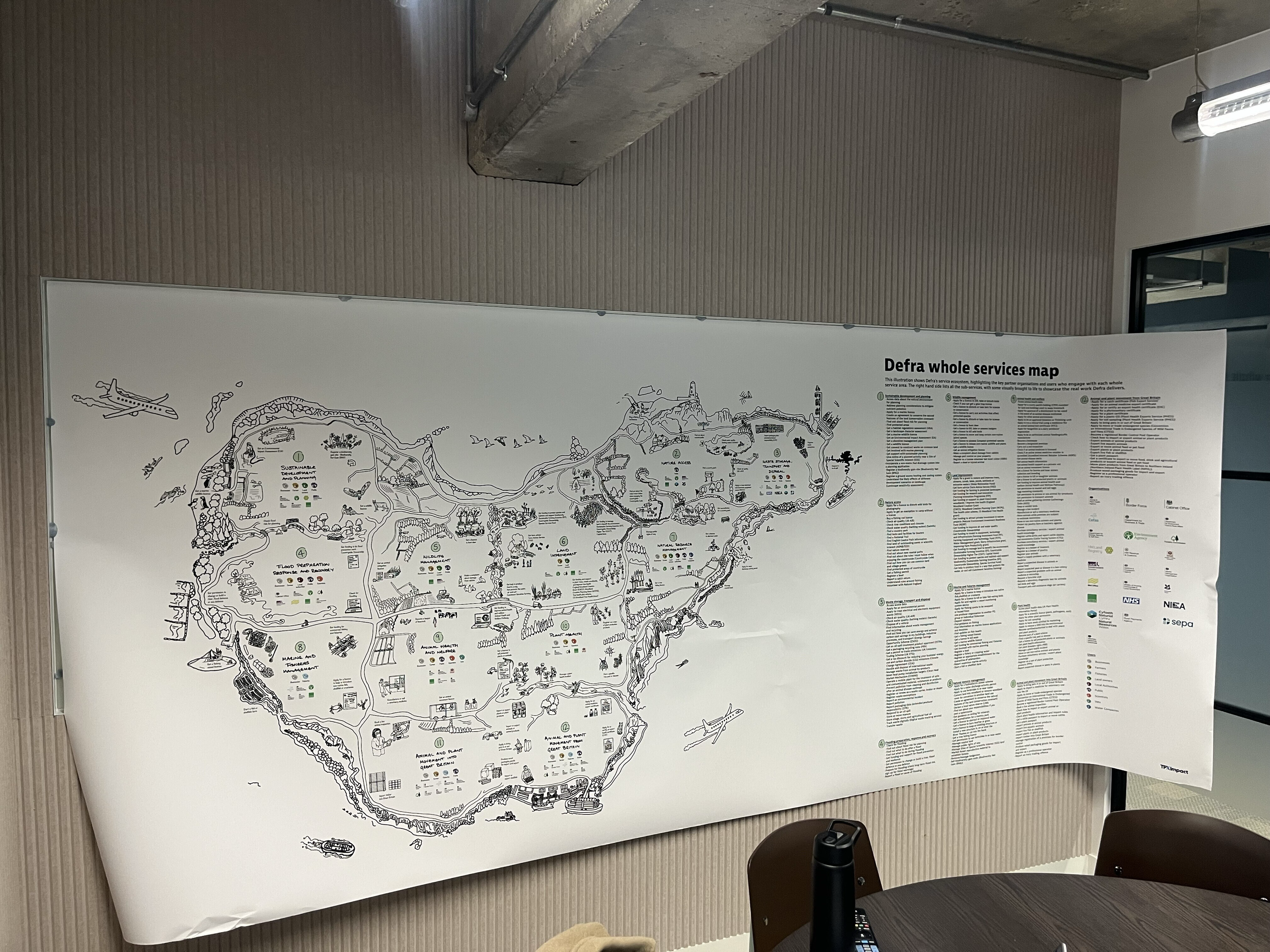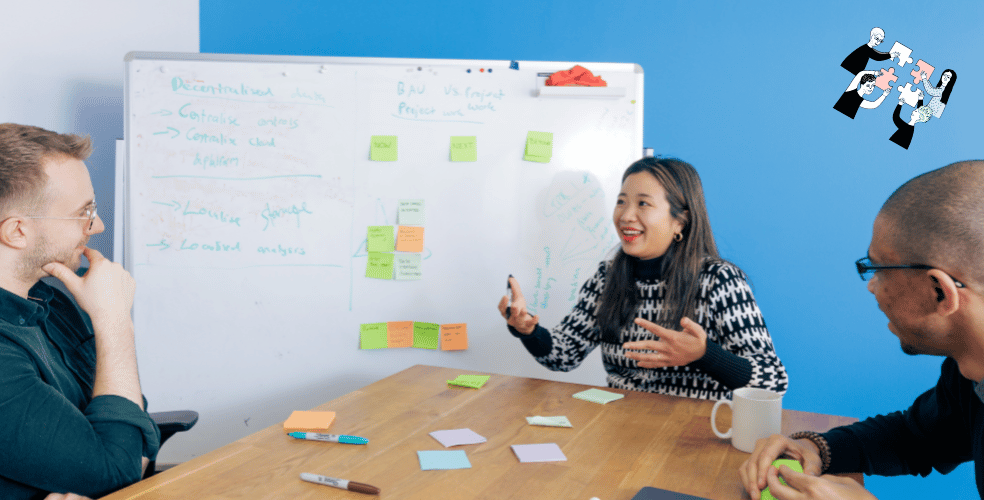When starting a new digital project, being adaptable is more important than ever. The traditional project management methods which were once our go-to now often struggle to keep pace with the evolving requirements and shifting demands of clients. A different, more innovative approach is needed to meet the demands of modern projects. This is where agile project management comes in – a transformative approach designed to empower teams, foster collaboration, and deliver value in a dynamic, high-paced environment.
At its core, agile is not just a methodology; it’s a mindset. It embraces change, values individuals and interactions over processes and tools, promotes client collaboration, and responds to change over rigid planning. By prioritising flexibility and adaptability, agile allows teams to thrive in an ever-changing landscape, ensuring every project is in the best possible place to succeed.
The evolution and benefits of agile methodologies
Agile isn’t a static concept; it's a continuously evolving philosophy. From its origins in software development, it has expanded its reach across industries, giving rise to various practices such as Scrum, Kanban, and Extreme Programming (XP). Each methodology offers its unique approach to agile principles, catering to diverse project needs and team dynamics, which we’ll expand on further down the line.
The benefits of adopting agile methodologies are wide-ranging. Breaking down complex projects into manageable increments, promotes early and continuous delivery of valuable work, raising end user satisfaction and reducing time to completion. It also enhances team collaboration, supports continuous improvement to ways of working, improves product quality, and mitigates project risks and the quality of software being built through feedback loops.
Foundational concepts
The Agile Manifesto
The Agile Manifesto emerged from a gathering of software developers in 2001. Frustrated with traditional, heavyweight software development methodologies, the group wanted to create a more flexible, customer-focused approach to software delivery. Over several days of intense discussion, they distilled their shared values and principles into the Agile Manifesto, signed in February 2001.
This declaration prioritised individuals and interactions, working software, customer collaboration, and responding to change over rigid processes and documentation. Since its inception, the Agile Manifesto has led to a revolution in software development and beyond, inspiring the adoption of agile methodologies, practices and frameworks across various industries, emphasising iterative development, continuous feedback, and delivering value to clients early and often.
Agile principles and values
Agile principles and values, stemming from the Agile Manifesto, form the cornerstone of this methodology, guiding project teams through the complexities of modern software development. They emphasise collaboration, flexibility, and customer-centricity, enabling teams to navigate uncertainty and deliver value effectively. These principles and values include:
-
Embrace change: Agile embraces change as a natural part of the development process. Teams are encouraged to welcome changing requirements based on customer feedback loops, even late in the project, to harness opportunities for innovation and adaptation.
-
Deliver working software frequently: Agile prioritises the early and continuous delivery of valuable software increments, which is key when working with the frequent feedback loops mentioned above. By delivering working software often, teams can gather feedback, validate assumptions, and respond to evolving customer needs promptly.
-
Promote sustainable development: Agile advocates for sustainable development practices that enable teams to maintain a consistent pace of work indefinitely. This includes balancing the workload, fostering a supportive work environment, and avoiding burnout to sustain long-term productivity and creativity.
Agile mindset and culture
An agile mindset lies at the heart of creating a transformative, agile culture. These teams foster a culture of transparency, accountability, and continuous improvement, empowering individuals to take ownership of their work and collaborate seamlessly towards shared goals.
Core agile practices
There are multiple frameworks and ways of working when it comes to agile, each with its own specific uses and benefits.
Overview of Scrum
Scrum, one of the most widely adopted agile frameworks, offers a structured approach to project management through defined roles, ceremonies, and artefacts. Key elements include sprint planning, daily stand-ups, sprint reviews, and retrospectives, culminating in iterative product increments and enhanced team collaboration.
In the Scrum framework, clear roles and responsibilities are essential for project success. The Product Owner acts as the voice of the customer, prioritising the product backlog and ensuring alignment with stakeholder needs. The Scrum Master serves as a servant-leader, facilitating team collaboration and removing impediments. The Development Team comprises of cross-functional members committed to delivering high-quality increments of work each sprint.
Understanding Kanban
Kanban, derived from the Japanese manufacturing philosophy, introduces a visual workflow management system aimed at maximising efficiency and minimising waste. By visualising work in progress, limiting work in process, and actively managing flow, this method enables teams to achieve a sustainable pace of delivery while maintaining a focus on customer value.
Unlike Scrum, Kanban does not prescribe specific roles. Instead, it emphasises shared responsibilities and collaboration within the team. Every team member plays a vital role in managing workflow, identifying bottlenecks, and optimising processes to enhance overall productivity and value delivery.
Exploring Extreme Programming (XP)
Extreme Programming (XP) advocates for engineering practices that prioritise software quality, such as test-driven development, pair programming, and continuous integration. By integrating these practices into the development process, XP enhances product quality, promotes collective code ownership, and accelerates feedback loops.
XP, like Kanban, does not rely on specific roles and emphasises shared responsibilities and collaboration within the team. However, there are certain key roles and responsibilities that contribute to the success of XP projects, including developers, testers, and coaches or facilitators.
Key agile tools
User stories and product backlog
User stories serve as the building blocks of agile project management, capturing stakeholder requirements from a user-first perspective. These specific narratives, housed within the product backlog, provide clarity and direction for the development team, guiding consistent product development and prioritisation efforts.
Backlog refinement and prioritisation
Backlog refinement is an ongoing process where the product backlog is continuously prepared and prioritised based on evolving requirements and stakeholder feedback. By refining the backlog regularly, teams ensure that the highest-priority items are ready for inclusion in upcoming sprints, maximising value delivery and client satisfaction.
Sprint planning and goals
Sprint planning marks the beginning of each Scrum process, during which the development team work together to select backlog items and define sprint goals. Through this, teams establish a clear direction for the upcoming phase of the project, allocate work based on capacity, and commit to completing key deliverables in a project.
Sprint reviews and demonstrations
Sprint reviews provide an opportunity for stakeholders to inspect and review the deliverables produced during the previous sprint and provide feedback. By engaging stakeholders and clients in regular reviews and demonstrations, teams gather valuable insights, validate assumptions, and ensure alignment with customer expectations, helping progress the project while building transparency and trust.
Sprint retrospectives
Sprint retrospectives offer a dedicated space for the project team to reflect on their process, identify areas for improvement, and adapt their practices accordingly. By creating a culture of continuous learning and improvement, sprint retrospectives empower teams to address challenges proactively, improve collaboration, and optimise their performance over time.
Implementing agile
Now we have an understanding of agile, it's time we talk about how we put it into action.
Setting up agile teams
Building high-performing agile teams requires careful consideration of team composition, dynamics, and culture. By building a culture of trust, empowerment, and collaboration, we can create an environment conducive to agile success, where teams thrive and deliver value consistently.
Initiation and planning
Kicking off an agile project involves defining the project vision, establishing goals, and assembling the project team. Through collaborative planning sessions and stakeholder engagement, teams gain clarity on project scope, objectives, and deliverables, setting the stage for successful execution.
Estimation and forecasting
Agile estimation techniques enable teams to understand where priorities and complexities lie and allocate resources effectively. These can include:
-
Relative sizing: Comparing the size or complexity of tasks relative to each other using scales like t-shirt sizes or the Fibonacci sequence.
-
Story points: Units of measure quantifying the effort needed for a user story, based on relative complexity and risk factors.
-
Planning poker: A collaborative estimation technique where team members use poker cards to estimate effort, fostering consensus and shared understanding.
By using these techniques, embracing uncertainty and leveraging historical data, teams can make informed decisions and adapt to changing circumstances while maintaining a sustainable pace of delivery.
Managing agile projects
Effective project management in agile requires a blend of leadership, facilitation, and adaptive planning. By employing agile frameworks and practices, monitoring progress through metrics, and fostering open communication, delivery managers can navigate complexity, mitigate risks, and drive successful project outcomes.
Monitoring progress with agile metrics
Agile metrics provide valuable insights into project performance, team productivity, and product quality. Common metrics we use include:
-
Mean lead time - the time it takes for an idea to get to production
-
Release frequency - how quickly things are developed and released
-
Change failure rate - how often things fail when they’re deployed
-
Meant time to recover - how long it takes to recover from a change failure failure
These enable teams to track progress, identify bottlenecks, and make data-driven decisions to optimise their workflow and enhance value delivery.
Handling change requests and adaptation
Change is often inevitable in agile projects, and teams must embrace it as an opportunity for growth and improvement. By fostering a culture of adaptability, responding to change, and collaborating with stakeholders, teams can address evolving requirements effectively and deliver valuable outcomes that meet customer needs.
Managing risks in agile projects
Agile projects are not immune to risks; however, agile provides a framework for proactive risk management and mitigation. By identifying potential risks early, prioritising them based on impact and likelihood, and implementing mitigating strategies iteratively, teams can navigate uncertainty and safeguard project success.
Overcoming Agile challenges
Agile adoption is not without its challenges. Resistance to change, lack of executive support, and cultural barriers can impede agile transformation efforts and potentially destabilise entire projects and plans. By acknowledging these challenges upfront, engaging stakeholders, and fostering a culture of learning and experimentation, we can overcome obstacles and realise the full potential of agile.
Strategies for overcoming resistance
Addressing resistance to agile requires a multifaceted approach that includes education, communication, and stakeholder engagement. By providing training, creating space for open dialogue, and demonstrating the benefits of agile through tangible outcomes, organisations can foster buy-in and cultivate a shared vision for its success.
Scaling agile for large projects or organisations
Scaling agile presents unique challenges related to coordination, communication, and alignment across multiple teams and departments. Fortunately, there are scaled agile frameworks that can help, such as:
-
FaST (Framework for Scaling Scrum): An agile scaling framework designed to extend the principles and practices of Scrum to larger organisations, offering guidance on coordinating multiple Scrum teams, managing dependencies, and aligning strategic objectives with agile delivery.
-
LeSS (Large-Scale Scrum): A lightweight framework for scaling Scrum to large organisations, emphasising simplicity and transparency to enable cross-functional collaboration and deliver value iteratively.
Using these means organisations can effectively coordinate efforts, manage dependencies, and scale agile principles and practices to the enterprise level. It is also important to remember that you can scale by making teams or work smaller and more focused, helping them remain agile even when working with larger projects and organisations.
Continuous improvement
Continuous improvement is at the heart of agile philosophy. By encouraging experimentation, soliciting feedback, and embracing a growth mindset, we can give our teams the time and space to work together to identify inefficiencies, implement iterative changes, and drive incremental enhancements.
Conducting agile retrospectives
Agile retrospectives provide a structured mechanism for teams to reflect on their process, celebrate successes, and identify areas for improvement. By facilitating open and honest discussions, fostering psychological safety, and implementing actionable takeaways, teams can harness the power of retrospectives to drive meaningful change and elevate performance.
Implementing feedback loops
Feedback loops are essential for iterative improvement in agile projects. By soliciting feedback from stakeholders, customers, and team members at regular intervals, teams can validate assumptions, course-correct as needed, and ensure alignment with evolving requirements, driving continuous value delivery and customer satisfaction.
Agile project management represents a transformative approach to delivering projects and value in a rapidly changing world. By embracing these principles, leveraging core frameworks and practices, adopting an agile mindset, and fostering a culture of continuous improvement, organisations can navigate complexity, mitigate risks, and deliver meaningful outcomes that exceed client expectations. As we embark on our agile journeys, we must always remember that success lies not only in the destination, but also on the road of learning, adaptation, and growth.

Beyond a blueprint: Visualising whole service areas
How we approached visualising a service eco-system for Defra.
Read moreOur recent insights
Transformation is for everyone. We love sharing our thoughts, approaches, learning and research all gained from the work we do.

Unlocking the benefits of AI for charities
How human-AI collaboration can help charities get true value from their data, turning insights into impact.
Read more
What's the future for open data in the UK?
A decade ago, the UK was a leader in open data, but its prominence has faded. We examine why the focus has shifted and what the future holds for the role of open data in the public sector.
Read more
The National Data Library: A new plan for joined-up government data
Will the National Data Library finally succeed in joining up government data? We examine the real organisational barriers and their potential role as enablers of data spaces.
Read more

